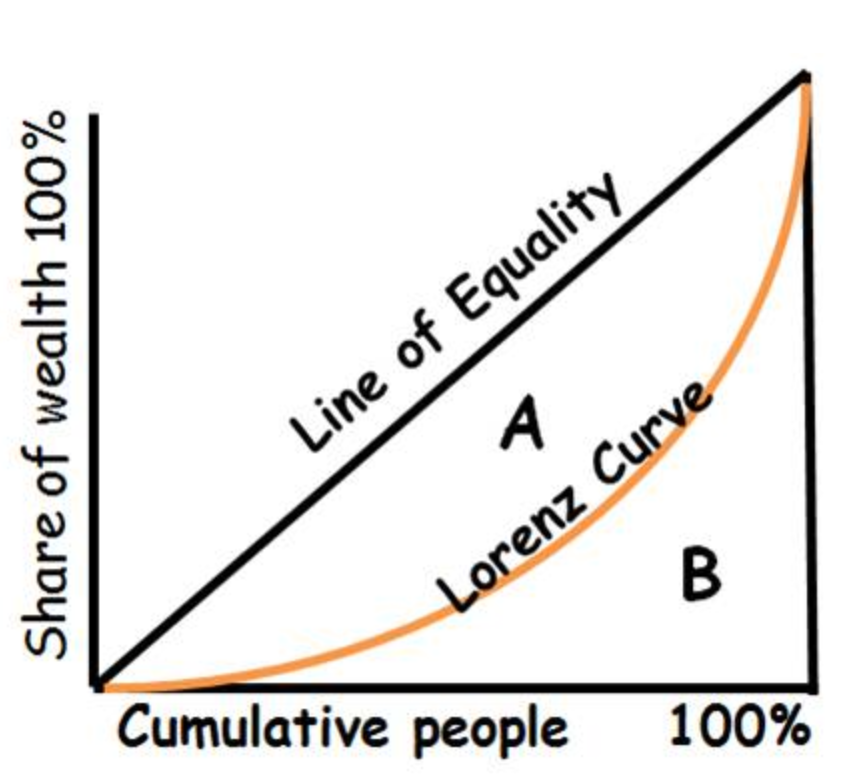AP Microeconomics Graphs and Formulas
1/48
There's no tags or description
Looks like no tags are added yet.
Name | Mastery | Learn | Test | Matching | Spaced |
|---|
No study sessions yet.
49 Terms
Allocative Efficiency Condition
P = MC, or more precisely, Marginal Social Benefit (MSB) = Marginal Social Cost (MSC)
Average Fixed Cost
AFC = Total Fixed Cost (TFC)
Average Product
AP = Total Product / Quantity of Input
Average Profit
Average Profit = Total Profit / Quantity
Average Revenue
Average Revenue = Total Revenue / Quantity
Average Total Cost
ATC = Total Cost (TC) / Quantity of Output (Q)
Average Variable Cost
AVC = Total Variable Cost (TVC) / Quantity of Output (Q)
Cross-Price Elasticity of Demand
Percentage Change in Quantity Demanded of Good X / Percentage Change in Price of Good Y
Distributive Efficiency Condition
MU_P / MU_C = F / C
Elasticity of Supply
Percentage Change in Quantity Supplied / Percentage Change in Price
Factor of Production Hiring Rule
Hire Until MRP = MFC
Gini Coefficient
Cumulative % of Income / Cumulative % of Families
Marginal Cost
MC = ΔTC / ΔQ
Marginal Product of Labor
MPL = ΔTP / ΔL
Marginal Revenue
MR = ΔTR / ΔQ
Marginal Revenue Product of Labor (MRPL)
MRPL = MPL × MRoutput
Optimal Combination of Resources Condition
w = MP_L / r
Optimal Consumption Rule
MU_X / P_X = MU_Y / P_Y
Price Elasticity of Demand
Percentage Change in Quantity Demanded / Percentage Change in Price
Price for a Competitive Firm
P = MR = AR
Production Efficiency Condition
w / r = MP_L / MP_K
Profit
Profit = TR - TC
Profit-Maximizing Output Level
MR = MC
Slope of the Total Product Curve
Slope = Change in Total Product / Change in the Number of Units of an Input
Socially Optimal Level of Output
MSB = MSC
Total Costs
Total Costs = Total Fixed Costs + Total Variable Costs, TC = TFC + TVC
PPC with increasing opportunity cost
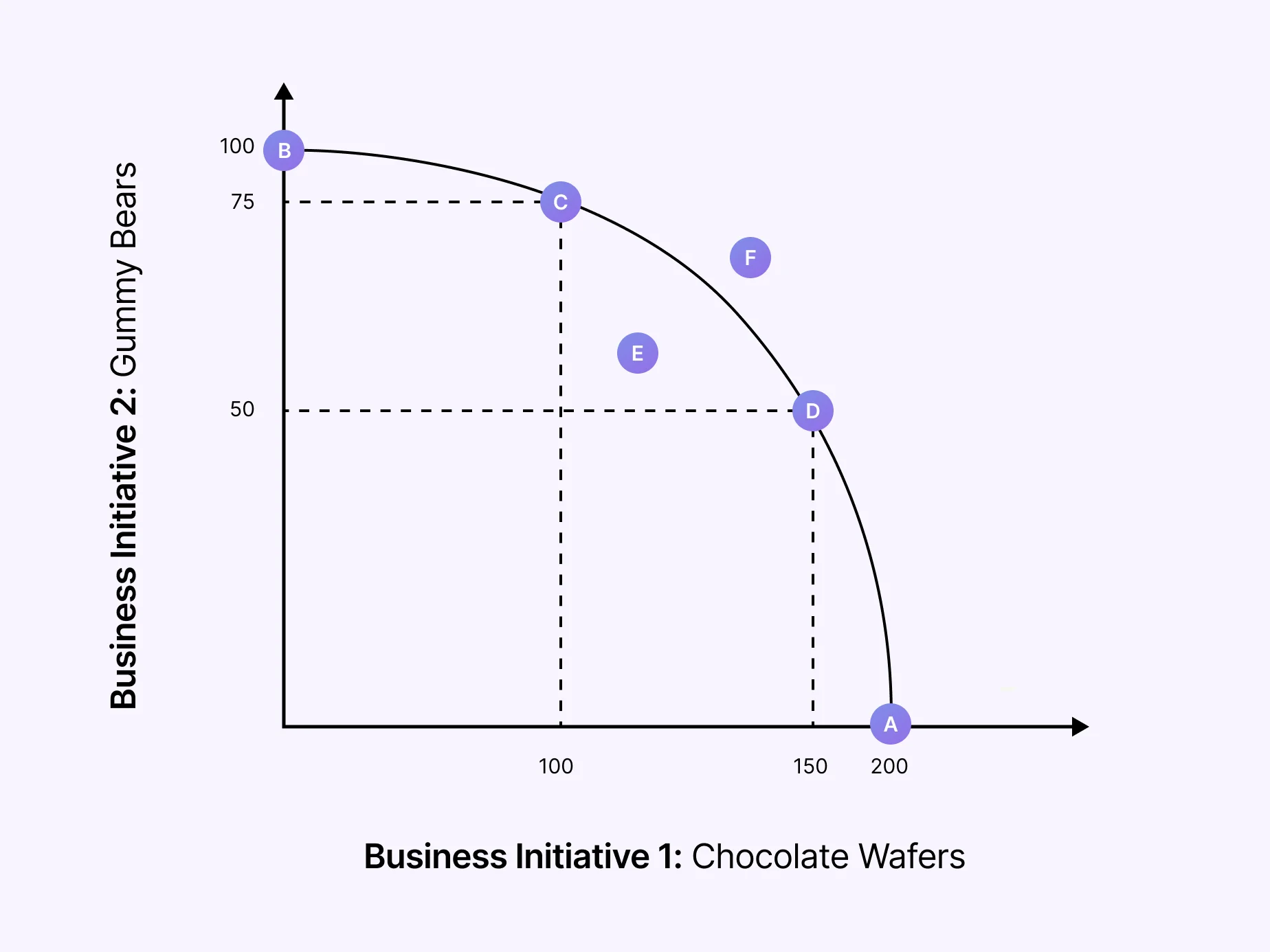
PPC with constant opportunity cost
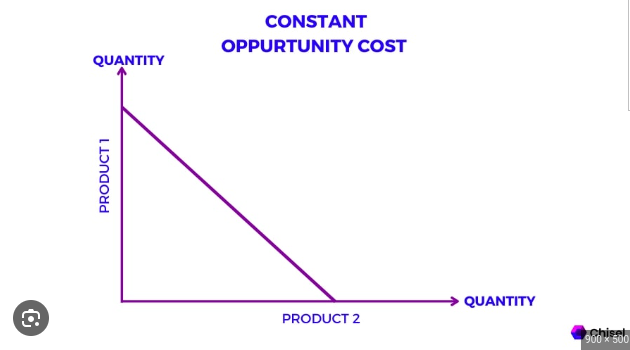
Long run average total cost curve
he LRAC illustrates the relationship between output and average cost when a firm can fully adjust all inputs. It represents the minimum average cost for each output level with the optimal input combination.
Shape of the LRAC Curve:
Downward Sloping (Economies of Scale): Initially, average costs fall as output rises, due to factors like specialization and spreading fixed costs.
Upward Sloping (Diseconomies of Scale): Beyond a certain point, average costs rise due to inefficiencies like poor coordination and communication.
Minimum Point: The lowest point on the curve shows the most efficient scale of production.
3. Key Concepts Related to LRAC:
Economies of Scale: Cost advantages from increased production, such as labor specialization and bulk purchasing.
Diseconomies of Scale: Rising costs from expanded production, due to management challenges and inefficiency.
Constant Returns to Scale: A situation where increasing production does not significantly affect average costs.
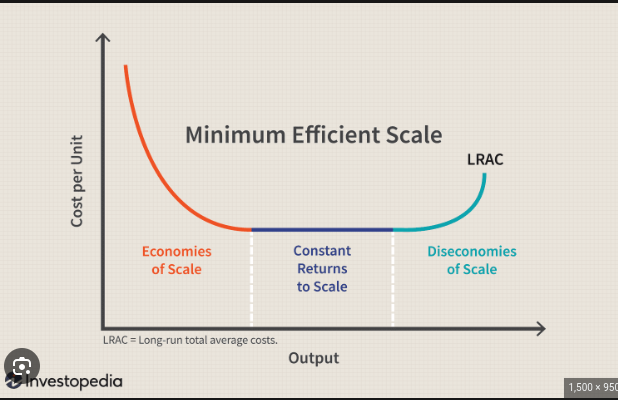
Perfect competition market and firm
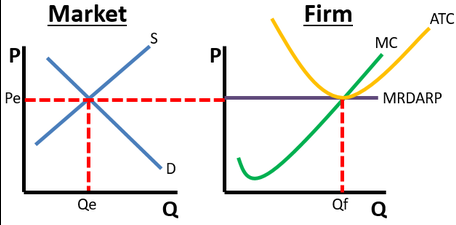
Non-price discriminating monopoly
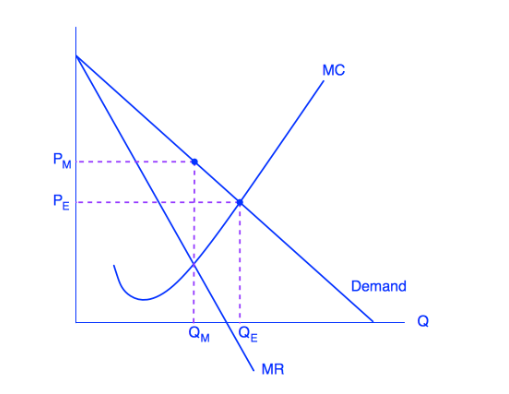
Monopoly making profit
1.The monopoly price and quantity Pu and Qu when if it is unregulated.
2.The allocatively efficient price and quantity. A government price ceiling here would cause the firm to incur a loss.
3. Fair return price. A price ceiling here would still be inefficient, but there would be less deadweight loss and the firm would break even so it would continue to operate in the long run.
4.If this is a monopolistically competitive market, firms would enter the market shifting MR and DARP left as this firms market share decreases.
**Monopolies have excess capacity and are not productively efficient (do not produce at the minimum of the ATC)
**Monopolies are not allocatively efficient (Price>MC) when they are unregulated.
**If a monopoly perfectly price discriminates, the MR merges with the DARP and they become allocatively efficient.
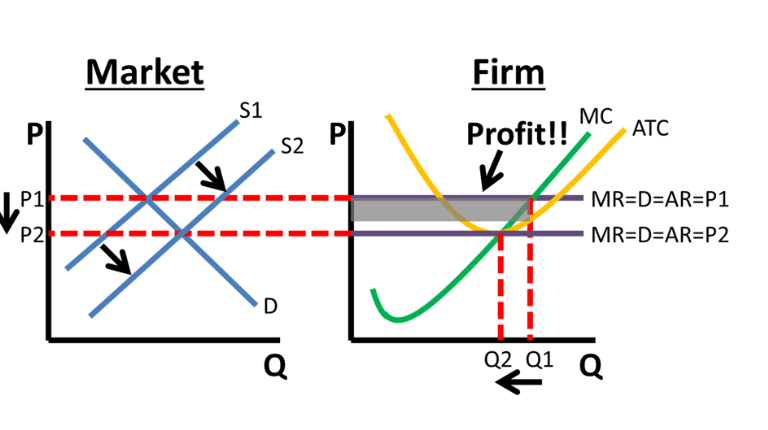
Monopolistic competition in the long run
1.Productive efficient point
(Minimum of ATC)
2.Allocative efficient point
(MC=P) quantity below
3.Actual output (MR=MC) and price (DARP above MR=MC at point 4)
5.Unit elastic portion of the demand curve (where MR equals zero at that quantity). Demand is inelastic below and elastic above this point.
•Deadweight loss is in the triangle between points 2,3, & 4.
•If the firm is making a profit (the ATC is lower than price), firms will enter the market giving each existing firm a smaller share of the market. That shifts DARP and MR to the left.
•If the firm is incurring a loss (ATC higher than price), the opposite occurs as firms exit the market.
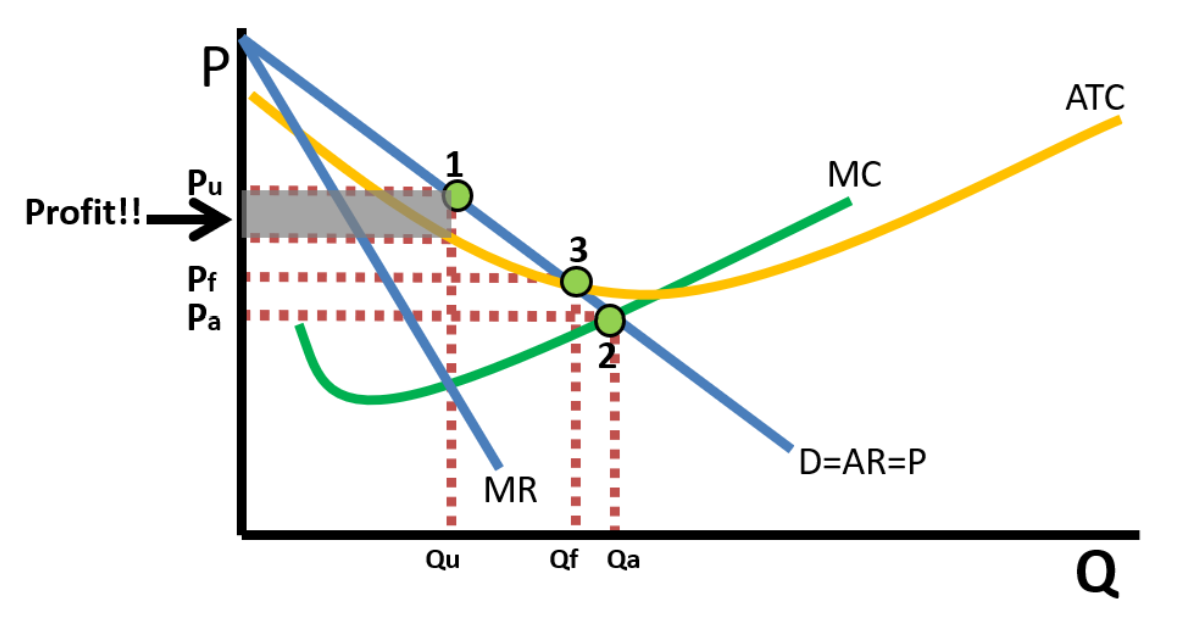
Natural monopoly
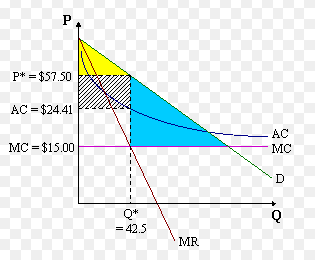
Price discriminating monopoly
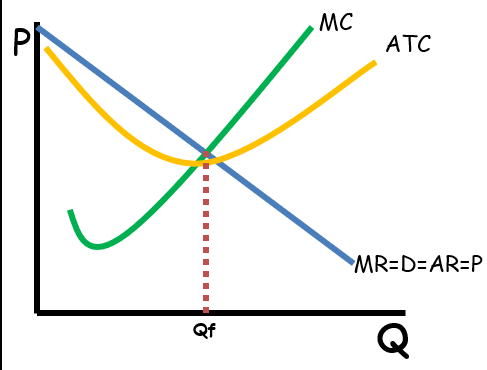
Perfect competition resource market and firm
Industry – When the supply of labor in the industry decreases (shifting supply to S2) the wage increases and the quantity of workers decreases
•Firm – The increase in the wage shifts the firm’s labor supply curve (MRC) upward. As a result, they hire fewer workers (Q2)
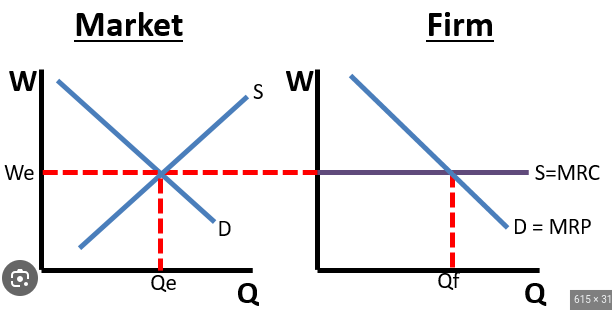
Monopsony Factor Market
Firm still hires the quantity where MRC=MRP
•Pm is the wage all workers are paid and Qm is the number the firm hires.
•Pc and Qc is the wage and number of workers hired if this were a competitive market. A monopsony hires fewer worker and pays lower wages than a competitive market.
•The MRC is higher than the wage (supply) because the firm must raise the wage for all of their workers when they hire more.
•1 and 2 are deadweight loss.
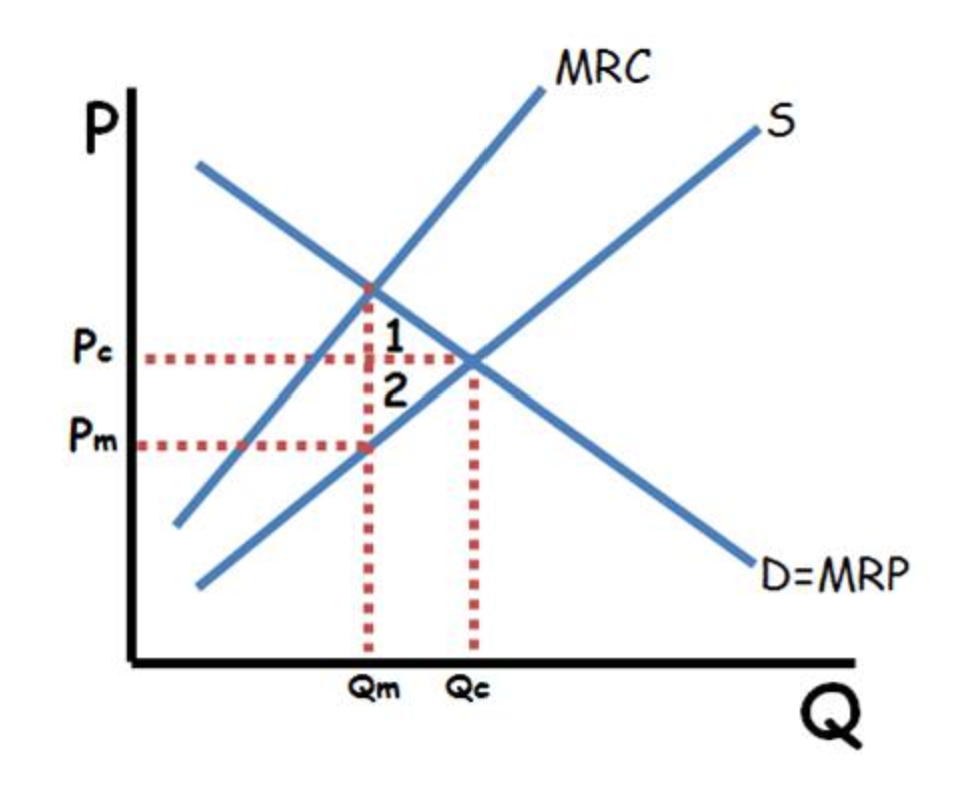
Supply and Demand
Single Shifts
•Demand ↑=P ↑ Q ↑: Point 1 to 2
•Demand ↓=P ↓ Q ↓: Point 1 to 8
•Supply ↑= P↓ Q↑: Point 1 to 6
•Supply ↓= P ↑ Q↓:Point 1 to 5
Double Shifts
•When 1 axis shows an increase then decrease with each shift, that axis is indeterminate.
•Demand ↓ Supply ↓
P Indeterminate Q ↓:Point 1 to 8 to 7.
•Demand ↑ Supply ↑
P Indeterminate Q ↑: Point 1 to 2 to 4.
•Demand ↑ Supply ↓
P ↑ Q Indeterminate: Point 1 to 2 to 3.
•Demand ↓ Supply ↑
P ↓ Q Indeterminate: Point 1 to 8 to 9
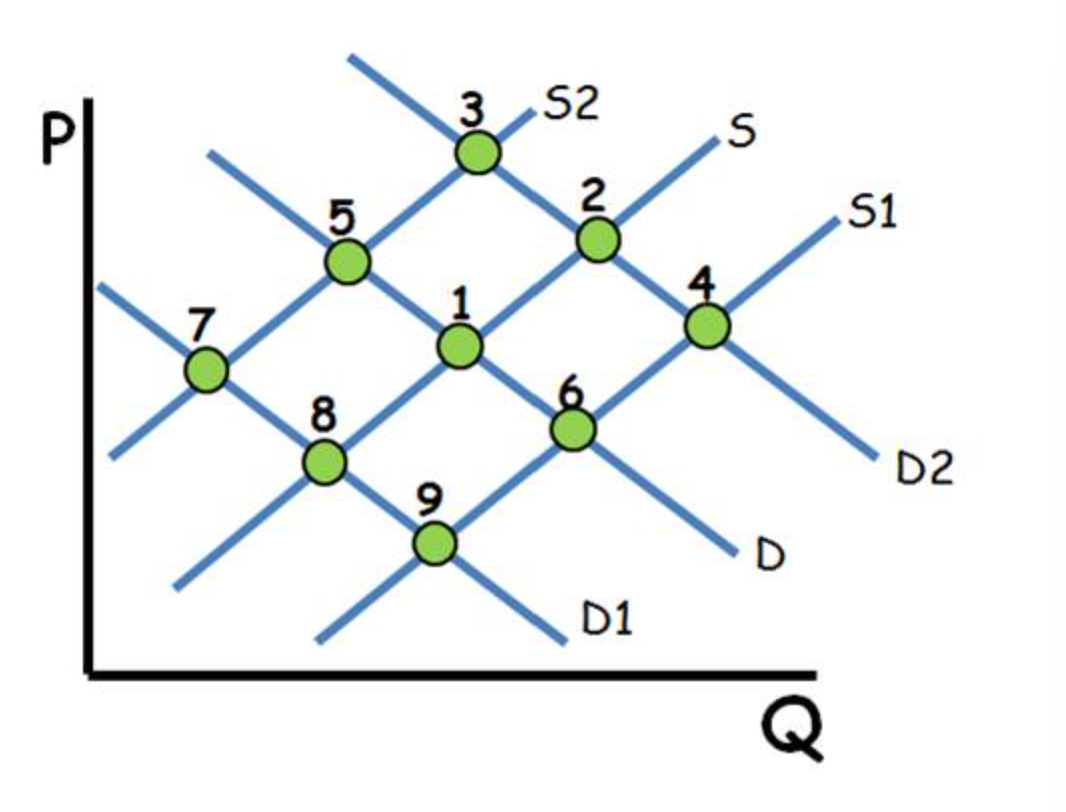
Price Floor
1.Triangle is deadweight loss
2.Producer surplus
3.Consumer Surplus
4.There is a surplus of products in the market (Qs>Qd)
•The quantity that actually exchanges hands is Qd (there can be more sold than consumers are willing to buy at the current price.

Price Ceiling
1.Triangle 1 is deadweight loss
2.Producer surplus
3.Consumer Surplus
4.There is a Shortage of products in the market (Qs<Qd)
•The quantity that actually exchanges hands is Qs (there can be more sold than producers are willing to sell at the current price.
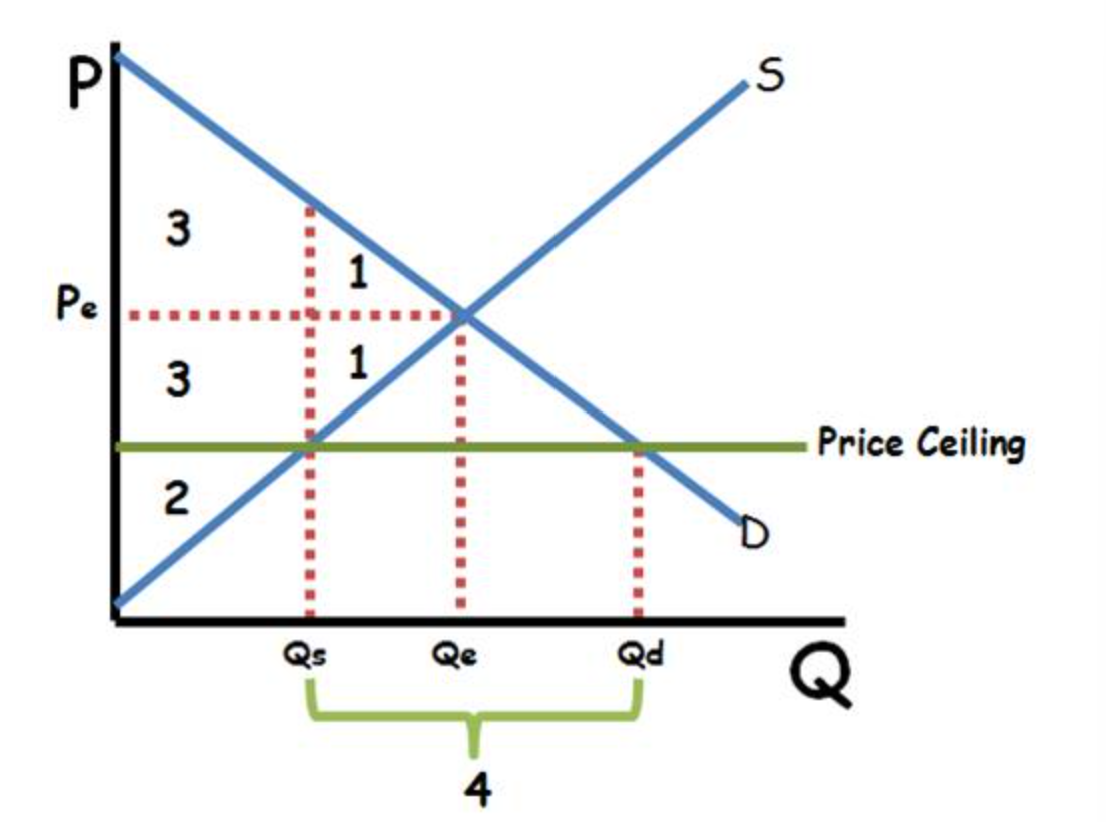
Per Unit Tax with no Externalities
Total Tax Revenue (1a + 1b)
1a Producer tax burden
1b consumer tax burden
2.Deadweight loss
3.Consumer Surplus
4.Producer Surplus
•Qt= Quantity produced and demanded
•Price of tax = P1-P2
•P1=Price consumers pay
•P2=Price producers receive
**This is a per-unit excise tax
**This tax reduces efficiency and creates deadweight loss.
**Tax revenue is part of economic surplus along with consumer and producer surplus.
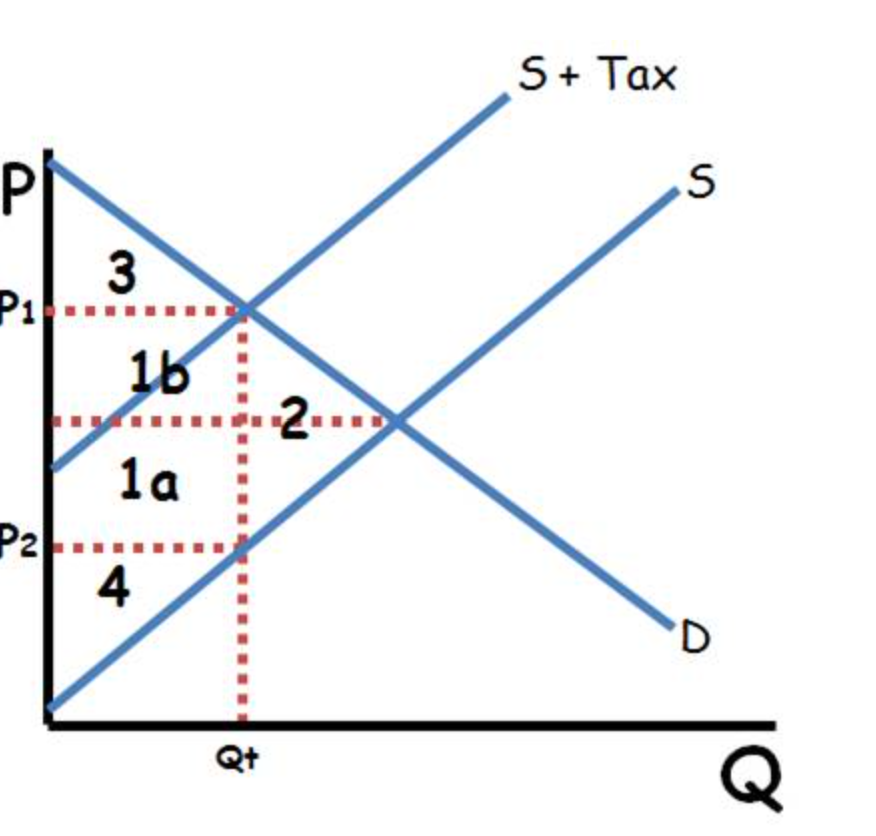
International Trade and Tariff
No trade:
•Pe and Qe equilibrium
•Consumer surplus A
•Producer surplus BCD
No Tariff:
•Pw is the price
•Q1 domestically produced.
•Q4 is consumed
•Q4-Q1 is imported
•Consumer surplus ABCEFGHIJ
•Producer Surplus D
With Tariff:
•Pw+Tariff is the price
•Q2 domestically produced
•Q3 domestically consumed
•Q3-Q2 is imported
•Consumer Surplus ABEF
•Producer Surplus CD
•Tax Revenue HI
•Deadweight loss GJ
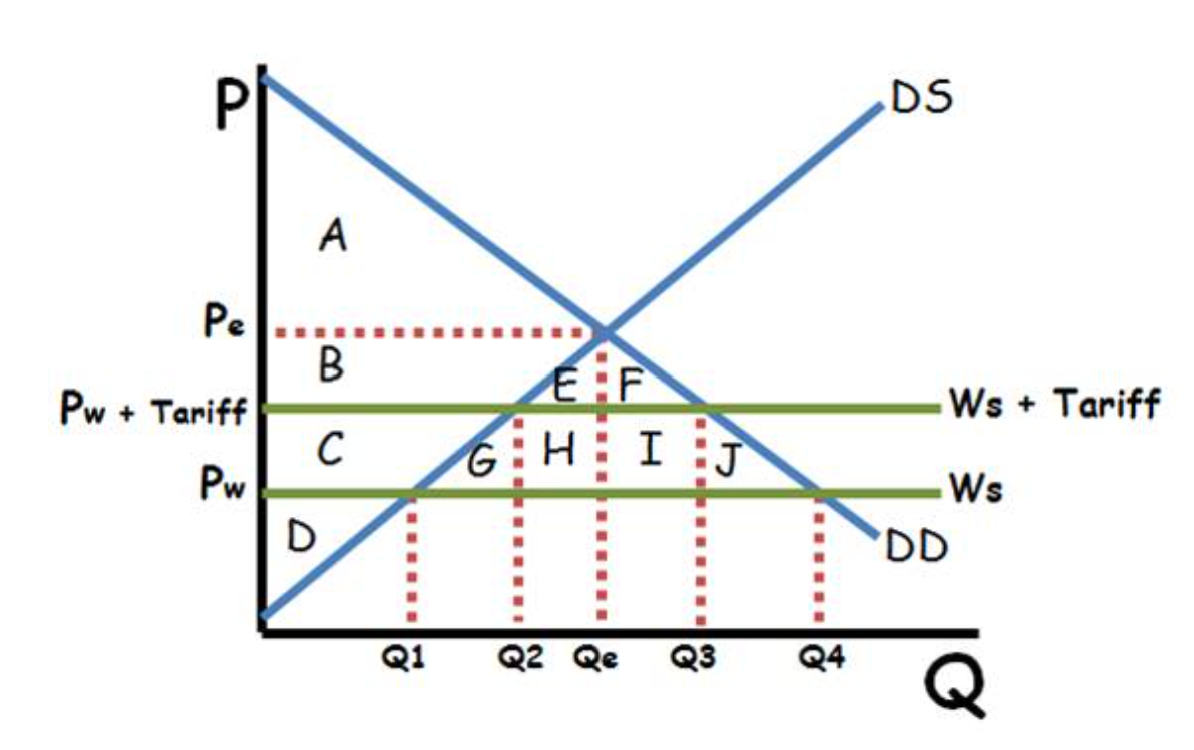
A Firm’s Cost Curves
•AFC – Represents all the costs the business must pay to operate even if they produce zero output. Also called sunk costs. i.e. rent, insurance, loan payments, lump sum tax etc. A change in Fixed costs only shifts the AFC and ATC (up or down)
•AVC – Represents the costs associated with producing more or less output. i.e. labor, raw materials, per unit tax, etc. A change in variable costs shifts the AVC, ATC, and MC (up or down)
•ATC = AVC + AFC
•MC = The costs associated with producing one more unit of output (impacted by variable costs)

Perfect Competition from short-run loss to long run equilibrium
The economic loss causes firms to exit the industry, shifting the supply curve left, raising the price (MRDARP) until the firm breaks even.
**Allocatively Efficient in the long-run and the short-run (Price=MC)
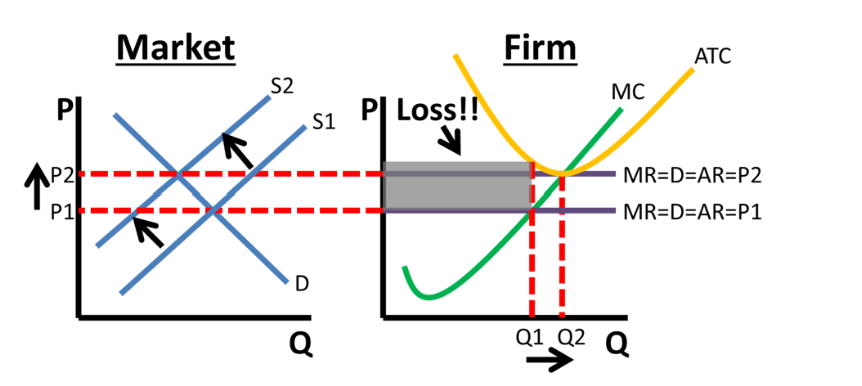
Perfect Competition from short-run profit to long run equilibrium
The economic profit causes firms to enter the industry, shifting the supply curve right, lowering the price until the firm breaks even.
**Productively efficient in the long run (produces at the minimum of the ATC).
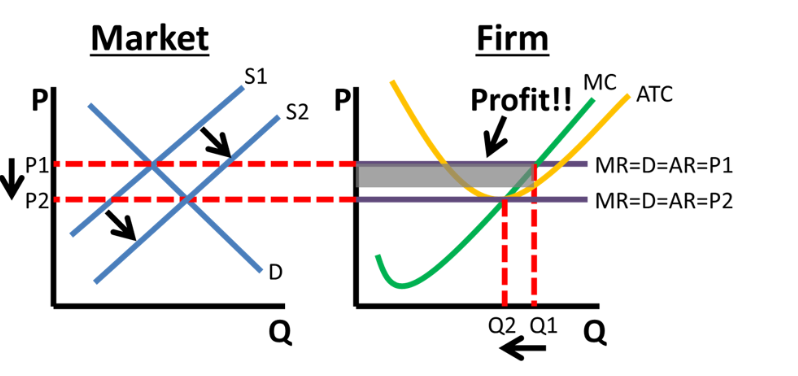
Negative Externalities with Per-Unit Excise Tax Correction
A.The output and price without government intervention. Inefficient because the MSC>MSB due to the externality
ABE = Deadweight loss before the tax (no deadweight loss after the tax) created by over production
B.The output and price after the tax. (The tax shifts the supply curve to the left)
CBP2P3=Total Tax Revenue
P2-P3=The price of the tax
CDP1P3=Tax paid by producer
BDP1P2= Tax paid by consumer
**Here the tax makes the market more efficient and reduces deadweight loss.

Positive Externalities with Per-Unit Consumer Subsidy Correction
B. The output and price without government intervention (inefficient because MSB>MSC)
C. The efficient output and price where MSC=MSB
ABC=the deadweight loss created by under production prior to the subsidy. There is no deadweight loss after the subsidy corrects this market failure.
P2-P3=The value of the subsidy.
P2P3DC= The total Cost of the Subsidy
**Here a tax would increase deadweight loss.
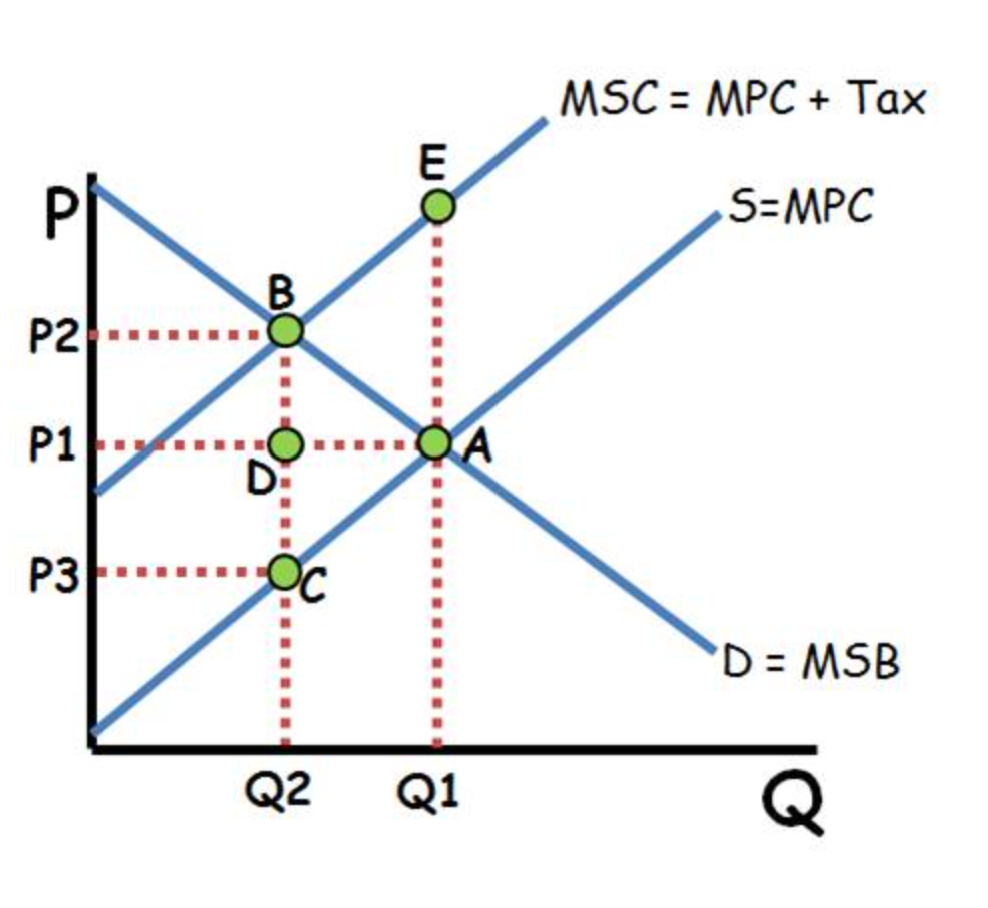
Positive Externality with Per-Unit Producer Subsidy Correction
C. Output and price without government intervention. Inefficient because MSB>MPC.
BCE=Deadweight loss created by underproduction. There is no deadweight loss after the subsidy
Since the subsidy is given to the producer instead, it shifts the supply curve to the right (MPC-Subsidy)
Q2. The efficient quantity where MSB equals MSC (No external cost so MSC is MPC).
P2 is the price suppliers receive after the subsidy.
P3 is the price consumers pay after the subsidy.
P2-P3=The value of the subsidy
P2P3AB=The Total Cost of the subsidy
**Here a tax would increase deadweight loss.
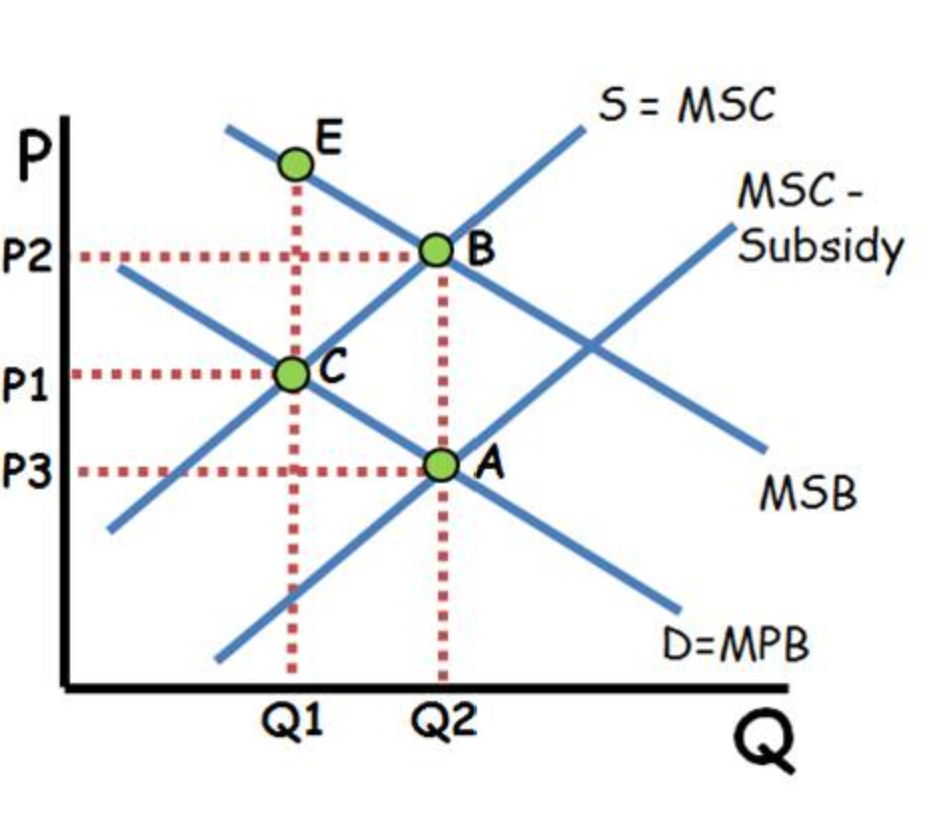
Lorenz Curve
•Lorenz curve – measures the distribution of wealth within a country.
•The closer the curve is to the line of equality, the more equal the distribution is.
•Gini Ratio = A/(A+B)
–Value of zero – Complete equality
–Value of one – Complete inequality
